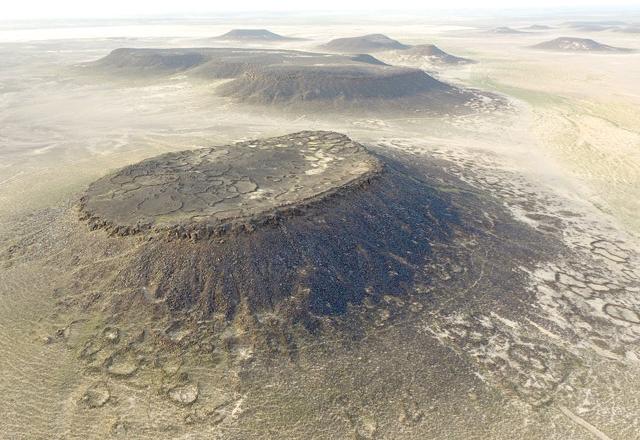You are here
Scholar explores reasons for demographic surge in Black Desert in ancient times
By Saeb Rawashdeh - Oct 26,2017 - Last updated at Oct 26,2017
AMMAN — During a lecture last week titled “Who Were the People in the Neolithic Black Desert?” held at the American Centre of Oriental Research (ACOR), American scholar Gary Rollefson addressed the causes of population growth in the Black Desert of eastern Jordan.
He examined the reasons for the 10 to 20-fold increase of the population of the Black Desert around 6,600BC, as well as the origins of the people who lived there.
According to Rollefson, who is an emeritus professor of anthropology at Whitman College and the National Endowment for Humanities Fellow at ACOR, 6,600BC marked a crucial turning point as the population of the basalt desert switched from hunters and gatherers to more sedentary groups who developed a new subsistence economy. They then became hunter-herders who focused on hunting gazelle and herding sheep and goats, he explained.
The scholar described how the modern landscape of the arid basalt desert used to be a place where semi-nomadic populations built permanent yet seasonally occupied dwellings at Wisad Pools at the eastern edge of the Black Desert, in the Wadi Al Qattafi at the western edge, and at several other sizeable settlements in between.
“Furthermore, there is evidence that indicate a more humid and more vegetated environment, a grassland that thrived until the end of the Early Bronze Age around 2,000 BC,” he said, adding “the change of the environment in the Black Desert was both caused by the climate change and by human activity, probably as a consequence of overgrasing and a dramatic drop in rainfall.”
“It was not simply due to the removal of vegetation by voracious sheep and goats but the breaking of top soil crust by literally thousands of hooves, exposing the top soil to water erosion, with even more damaging impact and to deflating winds,” the anthropologist explained.
Rollefson also discussed the origin of people who populated the area of the Black Desert, exploring three predominant hypotheses.
According to some archaeologists, domesticated caprines were “adopted” from western farmers by badia hunter-gatherers, leading to increased population growth in the harra, he said, stressing however the “many weaknesses” carried in this hypothesis.
The second hypothesis claims the existence of two populations in the harra “one that has its origins in farming settlements, but remained close to home, and the other that developed as it was mentioned in the first hypothesis”, the scholar explained, noting that this hypothesis implies that there was an intersection between two territories where populations bartered their goods.
For Rollefson, this hypothesis also has a weakness insofar as it does not explain the suddenness and the importance of the population growth, nor does it provide criteria to distinguish between the two populations or reasons why there were territorial boundaries if the size of the group had remained small.
The third hypothesis, which Rollefson believes to be the most accurate, states that in order to relieve pressure of goat and sheep herding on the farmland, part of the population took caprines away from their original settlements in the western part of Jordan and went to eastern badia during growing seasons, returning to settlements after the harvest until mid-autumn.
The reason for the dramatic increase in the population of the Black Desert was a major decrease of rainfall in the farming areas, and around the major settlements such as Ain Ghazal, Basta, and Kharaysan (between Jerash and Zarqa).
The combination of the drier climate and the exhausted soil made it impossible to feed the immense populations of the megasites, Rollefson said, noting that, altogether, up to 20,000 farmer-herders were forced to leave the permanent farming towns, most of whom took their sheep and goats east into the rich grasslands of the Black Desert.
The anthropologist finally suggested the presence of many different populations in the Black Desert in view of highly contrasting architectural traditions, difference in hunting practices, marked variability in group sizes and a noticeable degree of sedentism, all of which indicate heterogeneous groups in the basalt desert.
Related Articles
AMMAN — After the sharp decrease of precipitation around 7000BC, all of the known large Neolithic sites such as Basta, near Pet
AMMAN — The Western Harra Survey (WHS), started in 2015, has been investigating the north-east of the Azraq basin, noted a British archaeolo
AMMAN — Ain Ghazal (Spring of the Gazelles), near Marka in the capital, was “the Manhattan of the Neolithic period”, according to an anthrop

















